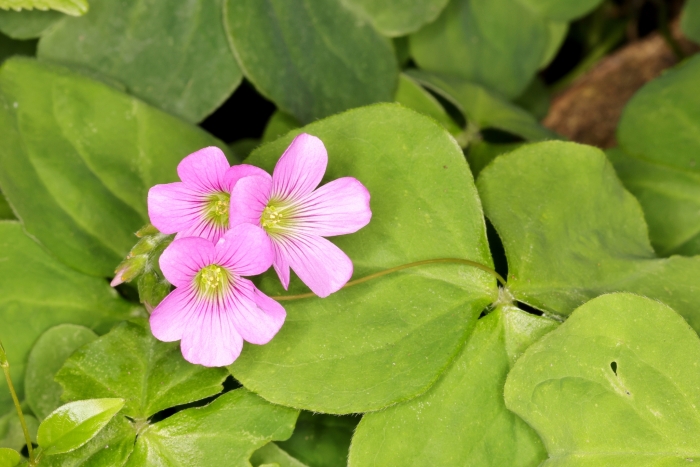Large-Flowered Pink-Sorrel
(Oxalis debilis)
Large-Flowered Pink-Sorrel (Oxalis debilis)
/
/

sk2
CC BY-SA 4.0
Image By:
sk2
Recorded By:
Copyright:
CC BY-SA 4.0
Copyright Notice:
Photo by: sk2 | License Type: CC BY-SA 4.0 | License URL: http://creativecommons.org/licenses/by-sa/4.0/ | Rights Holder: sk2 | Publisher: iNaturalist | Date Created: 2023-04-28T17:19:50-07:00 |

























Estimated Native Range
Summary
Oxalis debilis, commonly known as large-flowered pink-sorrel or pink woodsorrel, is a perennial herb that is originally native to South America. Despite its origins, it has become naturalized in many temperate and tropical regions around the world. It typically inhabits shady spots, often in gardens, woodlands, and urban areas where it can sometimes be found growing between cracks in pavements. The plant features delicate, heart-shaped leaves and showy pinkish-purple flowers that bloom from spring to fall, adding a splash of color to the landscape. The flowers are quite showy and can attract pollinators such as bees and butterflies.
Oxalis debilis is appreciated for its ornamental value, particularly its vibrant flowers and the refreshing lemon flavor of its leaves, which can be used in small quantities in salads and garnishes due to their oxalic acid content. It is often used in border planting or as a ground cover due to its low-growing habit and ability to spread easily. In cultivation, it prefers part shade to full shade, moist but well-drained soils, and can tolerate a range of soil types. While it can be propagated by seeds, it more commonly spreads by bulbils, which can make it somewhat invasive outside its native range. Gardeners should be cautious of its potential to spread and check local regulations before planting. It is also important to note that while the plant is edible, it should be consumed in moderation due to the presence of oxalic acid, which can be harmful in large amounts.CC BY-SA 4.0
Oxalis debilis is appreciated for its ornamental value, particularly its vibrant flowers and the refreshing lemon flavor of its leaves, which can be used in small quantities in salads and garnishes due to their oxalic acid content. It is often used in border planting or as a ground cover due to its low-growing habit and ability to spread easily. In cultivation, it prefers part shade to full shade, moist but well-drained soils, and can tolerate a range of soil types. While it can be propagated by seeds, it more commonly spreads by bulbils, which can make it somewhat invasive outside its native range. Gardeners should be cautious of its potential to spread and check local regulations before planting. It is also important to note that while the plant is edible, it should be consumed in moderation due to the presence of oxalic acid, which can be harmful in large amounts.CC BY-SA 4.0
Plant Description
- Plant Type: Herb, Bulb
- Height: 0.25-0.7 feet
- Width: 0.25-1 feet
- Growth Rate: Rapid
- Flower Color: Pink
- Flowering Season: Spring, Summer, Fall
- Leaf Retention: Deciduous
Growth Requirements
- Sun: Full Sun, Part Shade
- Water: Medium
- Drainage: Medium
Common Uses
Border Plant, Groundcover, Low Maintenance, Potted Plant, Rock Garden
Natural Habitat
Originally native to South America, now naturalized in many temperate and tropical regions, typically inhabiting shady spots in gardens, woodlands, and urban areas
Other Names
Common Names: Pink Woodsorrel, Vinagrillo Morado, Pink Shamrock
Scientific Names: , Oxalis debilis, Acetosella debilis, Acetosella grandifolia, Acetosella martiana, Ionoxalis canaminensis, Ionoxalis martiana, Oxalis bipunctata, Oxalis bipunctata, Oxalis bulbifera
GBIF Accepted Name: